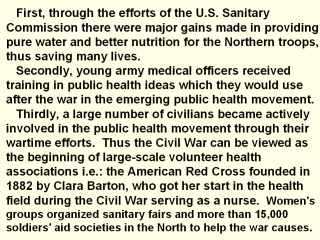| front |1 |2 |3 |4 |5 |6 |7 |8 |9 |10 |11 |12 |13 |14 |15 |16 |17 |18 |19 |20 |21 |22 |23 |24 |25 |26 |27 |28 |29 |30 |31 |32 |33 |34 |35 |36 |37 |38 |39 |40 |41 |42 |43 |44 |45 |46 |47 |review |
 |
Fourthly, wartime
hygiene concepts became widely known and at least somewhat accepted among
the civilian populace. Health pamphlets covering specific diseases and
written for the general public were widely distributed during the war. Fiftly, women were brought into the health care field in large numbers for the first time as nurses and, as just mentioned, as leaders of voluntary health associations. The individual Civil War soldier was taught a limited amount about personal hygiene, information he could use after the war. Seventhly, the Civil War firmly established that the federal government was supreme in the United States rather than the state governments. This point would allow federal governmental intervention into public health issues. in the 20th century. If the South had won, public health reform would have been doomed, as state governments in both the North and the South proved unable to solve interstate public health issues for the remainder of the 19th century. Even today state governments are ineffective in dealing with interstate public health concerns. |